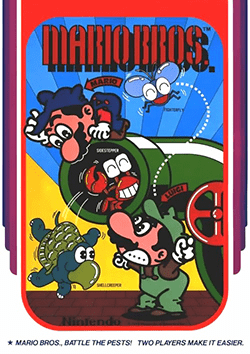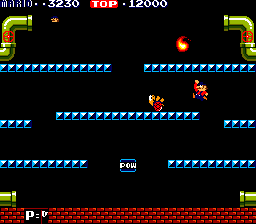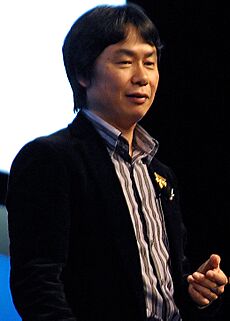Mario Bros. facts for kids
Quick facts for kids Mario Bros. |
|
|---|---|

North American arcade flyer
|
|
| Developer(s) | Nintendo R&D1 Intelligent Systems (NES) Nintendo R&D2 Atari, Inc. (2600, 5200) MISA (PC-8001) Choice Software (CPC, Spec) Ocean (C64) ITDC (7800) Sculptured Software (Atari 8-bit) |
| Publisher(s) |
Nintendo (arcade)
|
| Producer(s) | Gunpei Yokoi |
| Designer(s) | Shigeru Miyamoto Gunpei Yokoi |
| Composer(s) | Yukio Kaneoka |
| Series | Mario |
| Platform(s) |
|
| Release date(s) |
1983
Arcade
Famicom/NES
Atari 2600, 5200
PC-88
FM-7
Commodore 64 Amstrad CPC
Atari 7800
ZX Spectrum
Atari 8-bit
Nintendo e-Reader
Game Boy Advance
|
| Genre(s) | Platform |
| Mode(s) | Single-player, multiplayer |
Mario Bros. (sometimes nicknamed as Pipeline) is a platform game developed and published by Nintendo as an arcade video game in 1983. It was designed by Shigeru Miyamoto and Gunpei Yokoi, Nintendo's chief engineer. Italian twin brother plumbers Mario and Luigi exterminate creatures, like turtles (Koopas) and crabs emerging from the sewers by knocking them upside-down and kicking them away. The Famicom/Nintendo Entertainment System version is the first game produced by Intelligent Systems. It is part of the Mario franchise, but originally began as a spin-off from the Donkey Kong series.
The arcade and Famicom/Nintendo Entertainment System versions were received positively by critics. Elements introduced in Mario Bros., such as spinning bonus coins, turtles that can be flipped onto their backs, and Luigi, were carried over to Super Mario Bros. (1985) and became staples of the series.
An updated version, titled Mario Bros. Classic, is included as a minigame in all of the Super Mario Advance series and Mario & Luigi: Superstar Saga. Mario Bros. has been re-released through Nintendo's online stores for later systems.
Contents
Gameplay
Mario Bros. features two plumbers, Italian brothers Mario and Luigi, having to investigate the sewers after strange creatures have been appearing down there. The objective of the game is to defeat all of the enemies in each phase. The mechanics of Mario Bros. involve only running and jumping. Unlike future Mario games, players cannot jump on enemies and squash them, unless they were already turned on their back. Each phase is a series of platforms with pipes at each corner of the screen, along with an object called a "POW" block in the center. Phases use wraparound, meaning that enemies and players that go off to one side will reappear on the opposite side. The game has a point system, and continues until the player loses all lives.
Enemies are defeated by kicking them over once they have been flipped on their back. This is accomplished by hitting the platform the enemy is on directly beneath them. If the player allows too much time to pass after doing this the enemy will flip itself back over and recover.
There are four enemies which emerge from the pipes: the Shellcreeper; the Sidestepper; the Fighter Fly, which moves by jumping and can only be flipped when it is touching a platform; and the Slipice which turns platforms into slippery ice. A fifth enemy, fireballs, floats around the screen instead of sticking to platforms. "POW" blocks, which flips all enemies touching a platform or the floor when a player hits it from below, are also included. The game additionally contains bonus rounds.
Development
Mario Bros. was created by Shigeru Miyamoto and Gunpei Yokoi, two of the lead developers for the video game Donkey Kong. In Donkey Kong, Mario dies if he falls too far. For Mario Bros., Yokoi suggested to Miyamoto that Mario should be able to fall from any height, which Miyamoto was not sure of, thinking that it would make it "not much of a game." He eventually agreed, thinking it would be okay for him to have some superhuman abilities. He designed a prototype that had Mario "jumping and bouncing around", which he was satisfied with. The element of combating enemies from below was introduced after Yokoi suggested it, observing that it would work since there were multiple floors. However, it proved to be too easy to eliminate enemies this way, which the developers fixed by requiring players to touch the enemies after they've been flipped to defeat them. This was also how they introduced the turtle as an enemy, which they conceived as an enemy that could only be hit from below. Because of Mario's appearance in Donkey Kong with overalls, a hat, and a thick moustache, Miyamoto thought that he should be a plumber as opposed to a carpenter, and designed this game to reflect that. Another contributing factor was the game's setting: it was a large network of giant pipes, so they felt a change in occupation was necessary for him. The game's music was composed by Yukio Kaneoka.
A popular story of how Mario went from Jumpman to Mario is that an Italian-American landlord, Mario Segale, had barged in on Nintendo of America's staff to demand rent, and they decided to name Jumpman after him. Miyamoto also felt that the best setting for this game was New York because of its labyrinthine subterranean network of sewage pipes. The pipes were inspired by several manga, which Miyamoto states feature waste grounds with pipes lying around. In this game, they were used in a way to allow the enemies to enter and exit the stage through them to avoid getting enemies piled up on the bottom of the stage. The green coloring of the pipes, which Nintendo late president Satoru Iwata called an uncommon color, came from Miyamoto having a limited color palette and wanting to keep things colorful. He added that green was the best because it worked well when two shades of it were combined.
Mario Bros. introduced Mario's brother, Luigi, who was created for the multiplayer mode by doing a palette swap of Mario. The two-player mode and several aspects of gameplay were inspired by Joust. To date, Mario Bros. has been released for more than a dozen platforms. The first movement from Mozart's Eine kleine Nachtmusik is used at the start of the game. This song has been used in later video games, including Dance Dance Revolution Mario Mix and Super Smash Bros. Brawl.
Release

The arcade game was released in 1983, but there are conflicting release dates. Game Machine magazine reported that the game made its North American debut at the AMOA show during March 25–27 and entered mass-production in Japan on June 21. The book Arcade TV Game List (2006), authored by Masumi Akagi and published by the Amusement News Agency, lists the release dates as March 1983 in North America and June 1983 in Japan. Former Nintendo president Satoru Iwata said in a 2013 Nintendo Direct presentation that the game was first released in Japan on July 14, 1983.
Upon release, Mario Bros. was initially labeled as being the third game in the Donkey Kong series. For home video game conversions, Nintendo held the rights to the game in Japan, while licensing the overseas rights to Atari, Inc.
Ports and other versions
Mario Bros. was ported by other companies to the Atari 2600, Atari 5200, Atari 8-bit computers, Atari 7800, Amstrad CPC, and ZX Spectrum. The Commodore 64 has two versions: an Atarisoft port which was not commercially released and a 1986 version by Ocean Software. The Atari 8-bit computer version by Sculptured Software is the only home port which includes the falling icicles. An Apple II version was never commercially released, but copies of it appear to exist.
A port by Nintendo for the Nintendo Entertainment System (NES) was released in North America on June 23, 1986. Another NES port was released in August 1993 exclusively in Germany as part of the Classic Series.
In Taiwan and Mainland China, the game is sometimes nicknamed as Pipeline (管道) or Mr. Mary (瑪莉) due to the fact that pirated copies of this game were distributed very widely, and pirate companies could not use the real name of the game and characters to bypass copyright.
The NES version of Mario Bros. was ported via the Virtual Console service in North America, Australia, Europe and Japan for the Wii, Nintendo 3DS, and Wii U. The original arcade version of Mario Bros. was released in September 2017 for the Nintendo Switch as part of the Arcade Archives series. The NES version was a launch title for Nintendo Switch Online.
Nintendo included Mario Bros. as a bonus in a number of releases, including Super Mario Bros. 3 and the Game Boy Advance's Super Mario Advance series as well as Mario & Luigi: Superstar Saga, The NES version is included as a piece of furniture in Animal Crossing for the GameCube, along with many other NES games, though this one requires the use of a Nintendo e-Reader and a North America-exclusive Animal Crossing e-Card.
In 2004, Namco released an arcade cabinet containing Donkey Kong, Donkey Kong Jr. and Mario Bros. Mario Bros. was altered for the vertical screen used by the other games, with the visible play area cropped on the sides.
Legacy
Related games

In 1984, Hudson Soft made two different games based on Mario Bros. Mario Bros. Special, is a reimagining with new phases and gameplay. Punch Ball Mario Bros. includes a new gameplay mechanic: punching small balls to stun enemies. Both games were released for the NEC PC-8801, FM-7, and Sharp X1.
A version of the game was announced alongside the Virtual Boy hardware itself at Nintendo Space World 1994. Footage demonstrated showed a faithful recreation of the game, albeit with the Virtual Boy's trademark graphical qualities of monochrome red and black graphics and a slight stereoscopic 3D effect. Its demonstration was generally poorly received by video game publications, which lamented the selection of a decade-old game to demonstrate the technology of the new Virtual Boy hardware. Mario Bros. VB, as demonstrated, never released, though some gameplay concepts were utilized in Mario Clash (1995), a much more creative reimagining of the original Mario Bros.
Super Mario 3D World for the Wii U contains a version of Mario Bros. starring Luigi: Luigi Bros.
High score
On October 16, 2015, Steve Kleisath obtained the world record for the arcade version at 5,424,920 points verified by Twin Galaxies.
See also
 In Spanish: Mario Bros. para niños
In Spanish: Mario Bros. para niños



